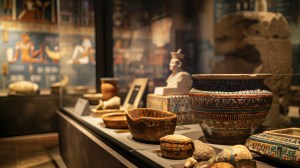Culinary Archaeology: Bringing Ancient Recipes Back to Life from Dusty Scrolls
Culinary archaeology is a fascinating field that merges history with gastronomy, allowing us to explore and experience the flavors of the past. This article delves into how researchers are uncovering ancient recipes hidden in dusty scrolls, bringing forgotten dishes back to life and enriching our modern culinary landscape.
The Intersection of History and Cooking
Ancient recipes provide a unique glimpse into the culinary traditions of bygone eras. They reveal not only what people ate, but also their cultural practices, agricultural methods, and even trade routes. Through the careful study of historical documents—such as scrolls, manuscripts, and inscriptions—archaeologists and historians can reconstruct these ancient meals. Every recipe tells a story about its origin, ingredients, and preparation techniques that connect us to our ancestors.

Discovering Ancient Texts
Many ancient culinary texts were written in languages long forgotten or were so fragile that they could barely be read without damaging them. However, technological advancements have allowed researchers to use digital imaging techniques like multispectral scanning to uncover faded scripts on dusty scrolls. This non-invasive method helps preserve the integrity of these texts while revealing hidden information about ancient cooking practices.
Reviving Forgotten Flavors
Once deciphered, these ancient recipes undergo testing by chefs and food historians who aim to recreate them using authentic ingredients as closely as possible to their original forms. For example, Roman cookbooks such as Apicius contain detailed instructions for dishes that can seem exotic today but are being revived in modern kitchens worldwide. By incorporating these old recipes into contemporary menus or home cooking practices, chefs create a bridge between past and present.
Cultural Significance of Ancient Recipes
The revival of ancient recipes is not just about recreating food; it’s also an exploration of identity and heritage. Many cultures take pride in their culinary history; thus reintroducing these dishes serves as a form of cultural preservation. Events like “Roman Feast Days” or themed dinners based on historical timelines allow communities to celebrate their heritage through shared meals rooted in tradition.
A Taste for Adventure: Exploring Culinary Archaeology Today
For those interested in experiencing these rediscovered flavors firsthand, many restaurants now feature menus inspired by culinary archaeology. Additionally, workshops led by experts offer home cooks an opportunity to engage with this unique aspect of gastronomy. Whether you’re an amateur chef or simply curious about history’s palate offerings, exploring ancient recipes can inspire creativity in your own kitchen.
In conclusion, culinary archaeology is breathing new life into old flavors found within dusty scrolls around the world. The journey from deciphering ancient texts to enjoying reconstructed meals is both thrilling and educational—connecting us all through shared experiences around food.
This text was generated using a large language model, and select text has been reviewed and moderated for purposes such as readability.











